Research on the Structural Performance of Liquid Nitrogen Ice Plugs on Nuclear Power Pipes
Abstract
1. Introduction
2. Modelling
2.1. Geometric Model
2.2. Mesh Independence Analysis
2.3. Boundary Condition
2.4. Physical Properties
3. Results and Discussion
3.1. Analysis of Temperature Distribution inside the Pipeline and Ice Formation Scenarios
3.2. Comprehensive Performance Comparison of Four Jacket Structures
3.3. Freezing Time and Liquid Nitrogen Consumption Corresponding to Five Types of Jackets under Liquid Nitrogen Gradient Flow Rate
3.4. Ice Volume Corresponding to Formation Time of Ice Plugs for Five Types of Jackets under Liquid Nitrogen Gradient Flow Rate
3.5. Comparison of Experimental and Simulation Results
4. Conclusions
- 1.
- The labyrinth and helical fin jackets exhibit lower internal temperatures at the moment of ice plug formation compared to the standard and center-offset jackets. Based on ice mechanics, the labyrinth jacket demonstrates higher ice plug strength;
- 2.
- Regarding the time of ice plug formation, at a liquid nitrogen flow rate of 0.1 m/s, the helical jacket has the shortest time at 423 s, but its liquid nitrogen consumption is significantly higher than the other four types. When considering nitrogen consumption, the helical fin jacket should be chosen at lower flow rates, while the standard jacket is preferable at higher flow rates;
- 3.
- In terms of ice formation volume, the helical jacket exhibits the largest ice formation, but its liquid nitrogen consumption is much higher than the other four types. When considering nitrogen consumption, the labyrinth jacket shows the largest volume;
- 4.
- Regarding the ice formation volume per kilogram of liquid nitrogen consumed, at a flow rate of 0.1 m/s, the helical fin jacket has a larger volume. At flow rates greater than 0.1 m/s, the labyrinth jacket shows a larger corresponding value. Therefore, considering all factors, the labyrinth jacket has the lowest energy consumption ratio. Compared with the single-jacket freezing method, the multi-jacket method can make the freezing time reduced by 11~22% and the liquid nitrogen consumption reduced by 18~26%.
Author Contributions
Funding
Data Availability Statement
Conflicts of Interest
References
- Aydin, G.; Jang, H.; Topal, E. Energy consumption modeling using artificial neural networks: The case of the world’s highest consumers. Energy Sources Part B Econ. Plan. Policy 2016, 11, 212–219. [Google Scholar] [CrossRef]
- Jin, L. Research on safety influencing factors and maintenance strategy of nuclear power operation. Ind. Technol. Forum 2022, 21, 224–225. [Google Scholar] [CrossRef]
- You, J.; Wu, J.; Xu, L.; Xie, Y.; Qiu, J.; Wan, L.; Qin, Q. Exploration on the comprehensive data reconciliation framework for unknown parameter inference in the nuclear power plant system. Appl. Therm. Eng. 2024, 247, 123138. [Google Scholar] [CrossRef]
- Huang, S.-X.; Zhang, J.-P.; Yang, W.-D.; Wang, Z.-F.; Hu, F.; Liu, F.; Sheng, L.; Zeng, Q.-C. Predicting and Controlling Nuclear Accident Hazards: Issues and Challenges. Aerosol Air Qual. Res. 2016, 16, 417–429. [Google Scholar] [CrossRef]
- He, S. Analysis of factors affecting the operational safety of nuclear power. Ind. Technol. Forum 2022, 21, 65–66. [Google Scholar] [CrossRef]
- Yang, H.S. Research on the influence factors of nuclear power operation safety. Mod. Enterp. Cult. 2019, 23, 191. [Google Scholar]
- Keary, A.C.; Bowenl, R.J. On the prediction of local Ice formation in pipes in the presence of natural convection. J. Heat Transf. 1999, 121, 934–944. [Google Scholar] [CrossRef]
- Shamsundar, N. Approximate calculation of multidimensional solidification by using conduction shape factors. ASME Trans. J. Heat Transf. 1982, 104, 8–12. [Google Scholar] [CrossRef]
- Xie, L.J.; Shen, X.; Lin, H.B.; Zhang, W.; Hu, M.L.; Bian, C.H. Study of liquid nitrogen ice plug test and its stress distribution in industrial pipelines. Cryog. Eng. 2020, 6, 38–43. [Google Scholar]
- Wang, H.Y. Research on the Application of Ice Plug Technology in Nuclear Power Plants. Master’s Thesis, Shanghai Jiaotong University, Shanghai, China, 2006. [Google Scholar]
- Li, W.; Zhou, L.K.; Yuan, Y.; Yuan, Y.; Fang,, Q.S.; Qiao,, Y.L. Simulation of Ice Plug Formation and Material Damage Characteristics in Depressurization System Pipelines of Generation III Nuclear Power Plants. Nucl. Sci. Eng. 2023, 43, 1049–1058. [Google Scholar] [CrossRef]
- Corbescu, B.; Puiu, D.; Gyongyosi, T.; Panaitescu, V. Forming an ice plug inside a high diameter pipeline in stationary water using a nitrogen vapour exhaust restriction. J. Phys. Conf. Ser. 2018, 1122, 012002. [Google Scholar] [CrossRef]
- Gyongyoşi, T.; Valeca, Ș.; Deloreanu, G.I.R. Încercări de formare a dopului de gheaţă într-o conductă orizontală umplută cu apă, în regim static (fără circulaţia fluidului). ICN Piteşti, 2007, 7997.
- Gyongyoşi, T.; Valeca, Ș.; Puiu, D.I.R. Influenţa mărimii orificiului de evacuare în procesul formării dopului de gheaţă în conducta orizontală cu Dn 200 mm în absenţa curgerii apei demineralizate. SCN Piteşti 2014, 10220.
- Du, J.L.; Xie, H.T. Application of ice plugging method on 600MW thermal power units. Sci. Technol. Innov. 2018, 32, 66–67. [Google Scholar]
- Liu, F.L.; Fan, S.K.S.; Ndi, E.; Tu, J.F. An Efficient no-shutdown pipe-fixing freezing design for water management system in hospitals during COVID-19: A case study. Water 2021, 13, 2725. [Google Scholar] [CrossRef]
- Gui, L.; Liu, J. Ice valve for a mini/micro flow channel. J. Micromech. Microeng. 2004, 14, 242–246. [Google Scholar] [CrossRef]
- Takefuj, Y.; Okubo, T. Double-ice-plug freezing using liquid nitrogen for water pipe repairs. Urban Water J. 2018, 15, 97–99. [Google Scholar] [CrossRef]
- You, Q.; Mo, N.; Liu, X.N.; Luo, H.; Shi, Z. Experiments on helium breakdown at high pressure and temperature in uniform field and its simulation using COMSOL Multiphysics and FD-FCT. Ann. Nucl. Energy 2020, 141, 107351. [Google Scholar] [CrossRef]
- Xu, P.; Xiao, Y.Y. Advances in Enhanced Heat Transfer Technologies for Shell-and-Tube Heat Exchangers. Mech. Electr. Equip. 2020, 37, 5. [Google Scholar] [CrossRef]
- Shi, M.Z.; Wang, Z.Z. Principles and Design of Heat Exchangers; Southeast University Press: Nanjing, China, 2009; p. 265. [Google Scholar]
- Hu, B. Study on the Impact of Baffle Structures on the Performance of Shell-and-Tube Heat Exchangers. Master’s Thesis, Jianghan University, Wuhan, China, 2022. [Google Scholar]
- Li, H.; Kottke, V. Effect of baffle spacing on pressure drop and local heat transfer in shell-and-tube heat exchangers for staggered tube arrangement. Int. J. Heat Mass Transf. 1998, 41, 1303–1311. [Google Scholar] [CrossRef]
- Russ, G.; Beer, H. Heat transfer and flow field in a pipe with sinusoidal wavy surface—I. Numerical investigation. Int. J. Heat Mass Transf. 1997, 40, 1061–1070. [Google Scholar] [CrossRef]
- Cui, H.T.; Yuan, X.G. Study on the Comprehensive Performance of Spiral Grooved Tubes. Petrochem. Equip. Technol. 2001, 22, 6–8. [Google Scholar]
- Xiao, J.H.; Qian, C.F.; Huang, Z.X.; An, W.Z. Study on Flow and Heat Transfer Enhancement in Corrugated Tubes. J. Beijing Univ. Chem. Technol. 2006, 3, 70–74. [Google Scholar]
- Jiang, X.; Peng, Z.M.; Hu, W.X. Experimental Study on Heat Transfer Performance of Fluid in Twisted Tri-Lobed Tubes. In Proceedings of the 2014 Annual Conference of the Chinese Society of Engineering Thermophysics, Xi’an, China, 31 October–3 November 2014. [Google Scholar]
- Zhang, F.; Li, Z.H.; Li, X.Y.; Ding, J.; Chen, L.; Tao, W.Q. Experimental Study on the Heat Exchanger Characteristics of Finned Tubes Made of Different Materials. J. Xi’an Jiaotong Univ. 2015, 5, 62–67. [Google Scholar]
- Qiu, G.T.; Feng, Y.C. Corrugated Tube Heat Exchangers (Part 1)—Origin, Current Status, and Development. Pipeline Technol. Equip. 1998, 1, 47–49. [Google Scholar]
- Liu, M.Q.; Mukhe, R. Double bow-shaped folded plate shell and tube heat exchanger. Petrochem. Equip. Technol. 1993, 14, 18–21. [Google Scholar]
- Li, Y.; Liu, Z.Y.; An, Y.R. Introduction to Fluent, a generalized software for computational fluid dynamics. Hydrodyn. Res. Prog. 2001, 2, 254–258. [Google Scholar]
- Guo, Y.K.; Meng, W.Y. Experimental study on the mechanical properties of ice. J. North China Univ. Water Conserv. Hydropower 2015, 36, 40–43. [Google Scholar]
- Ouyang, Q.A. Experimental Study on Mechanical Properties of Static and Dynamic Ice and Numerical Simulation of Particle Discrete Element Method. Ph.D. Thesis, Tianjin University, Tianjin, China, 2019. [Google Scholar]
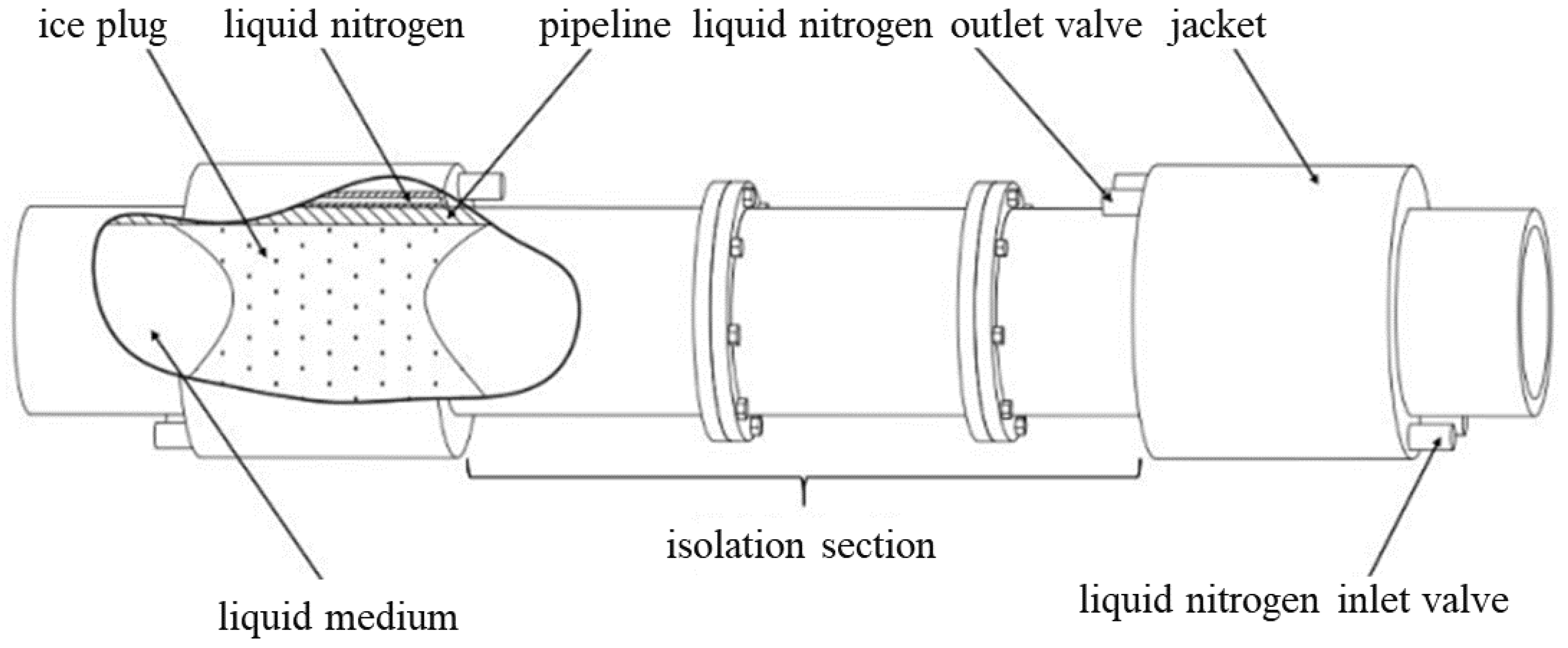
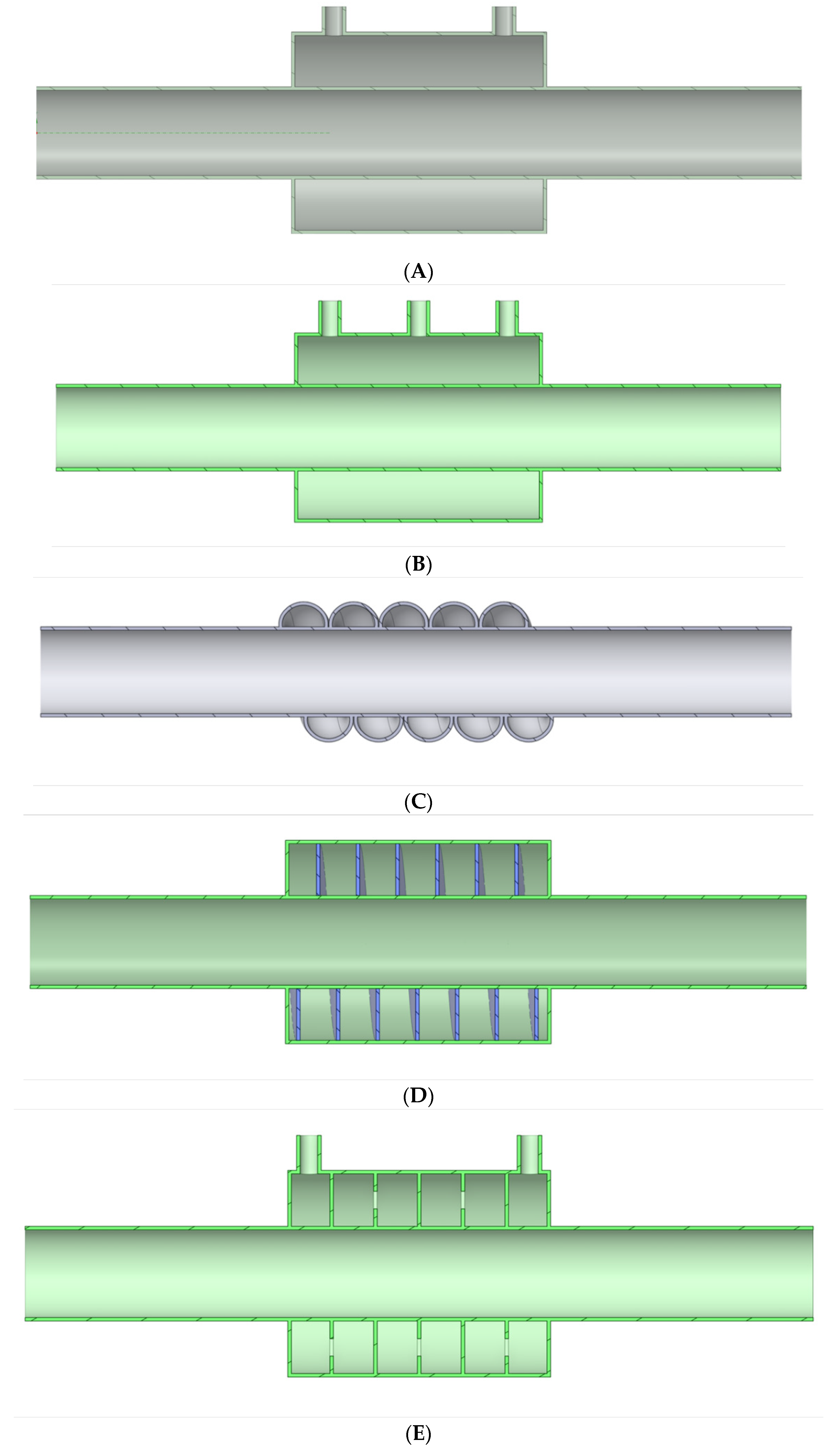


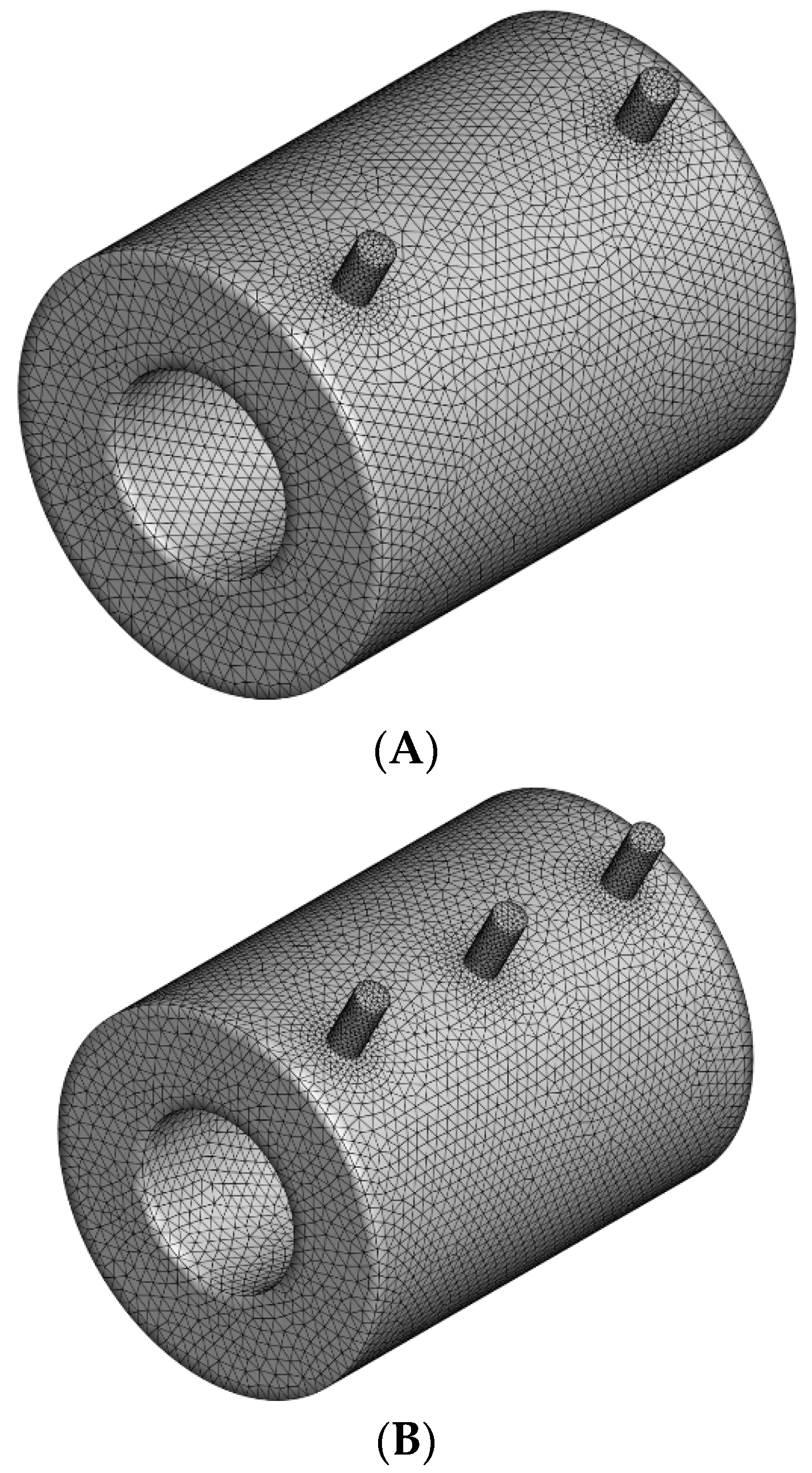

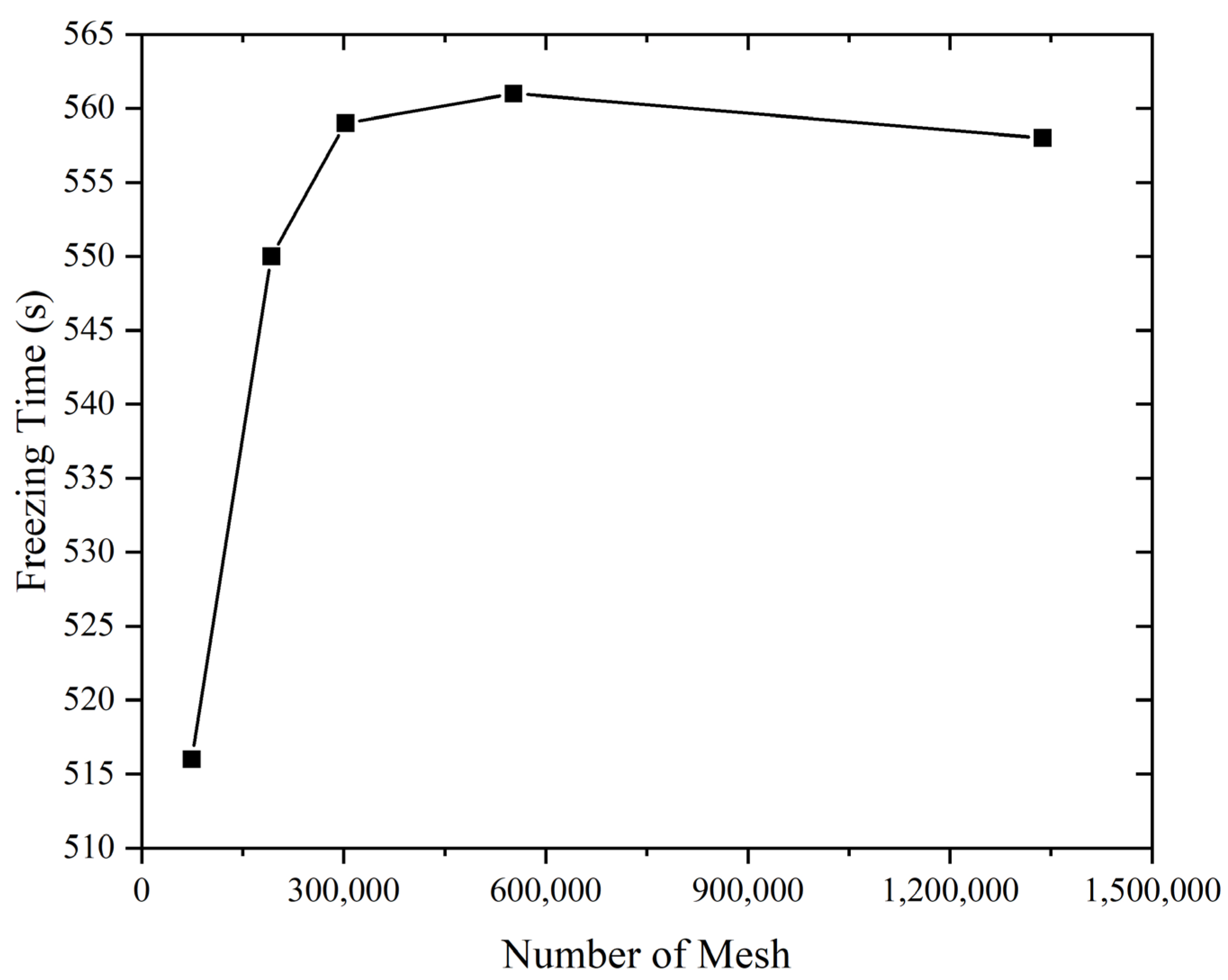




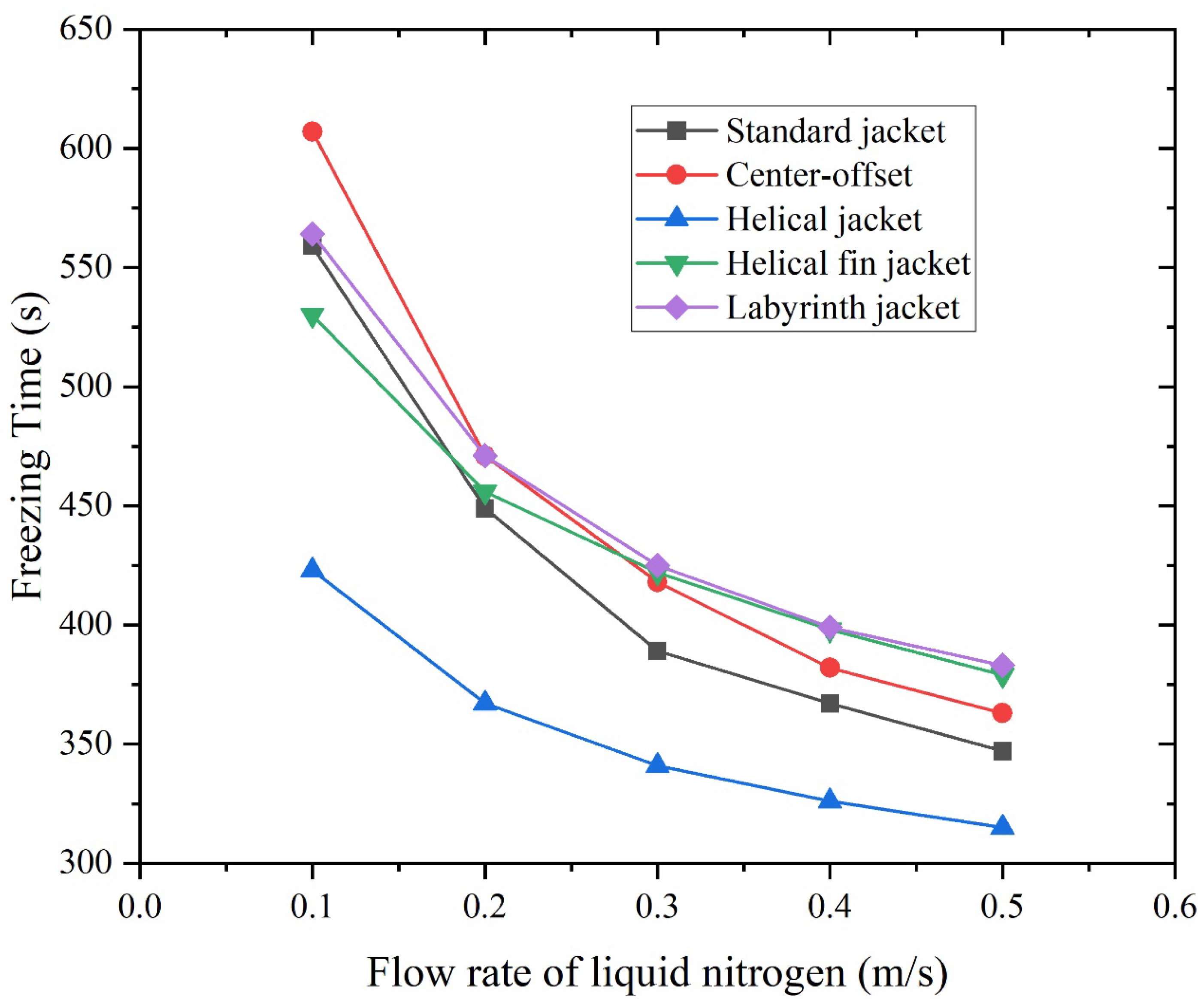

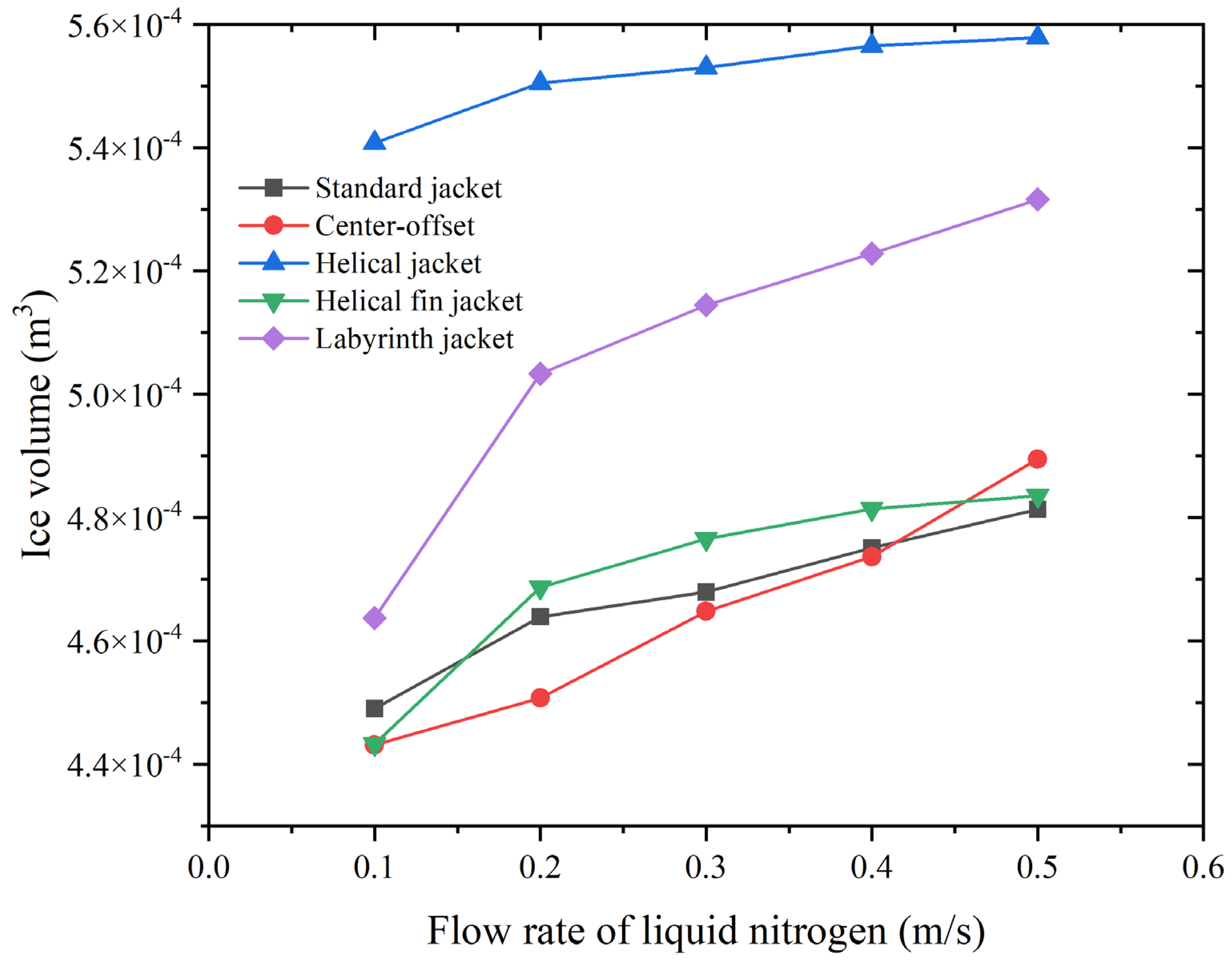
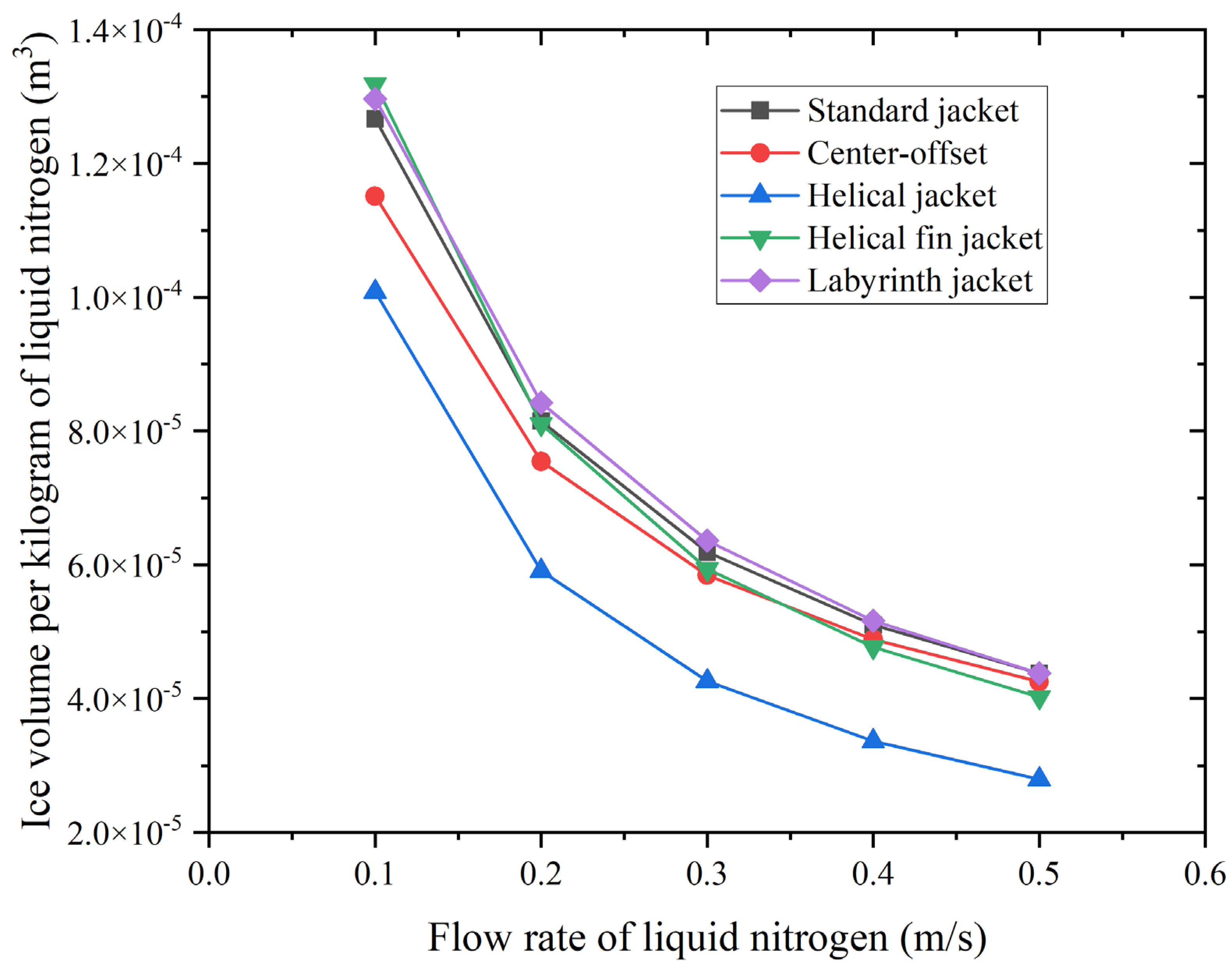
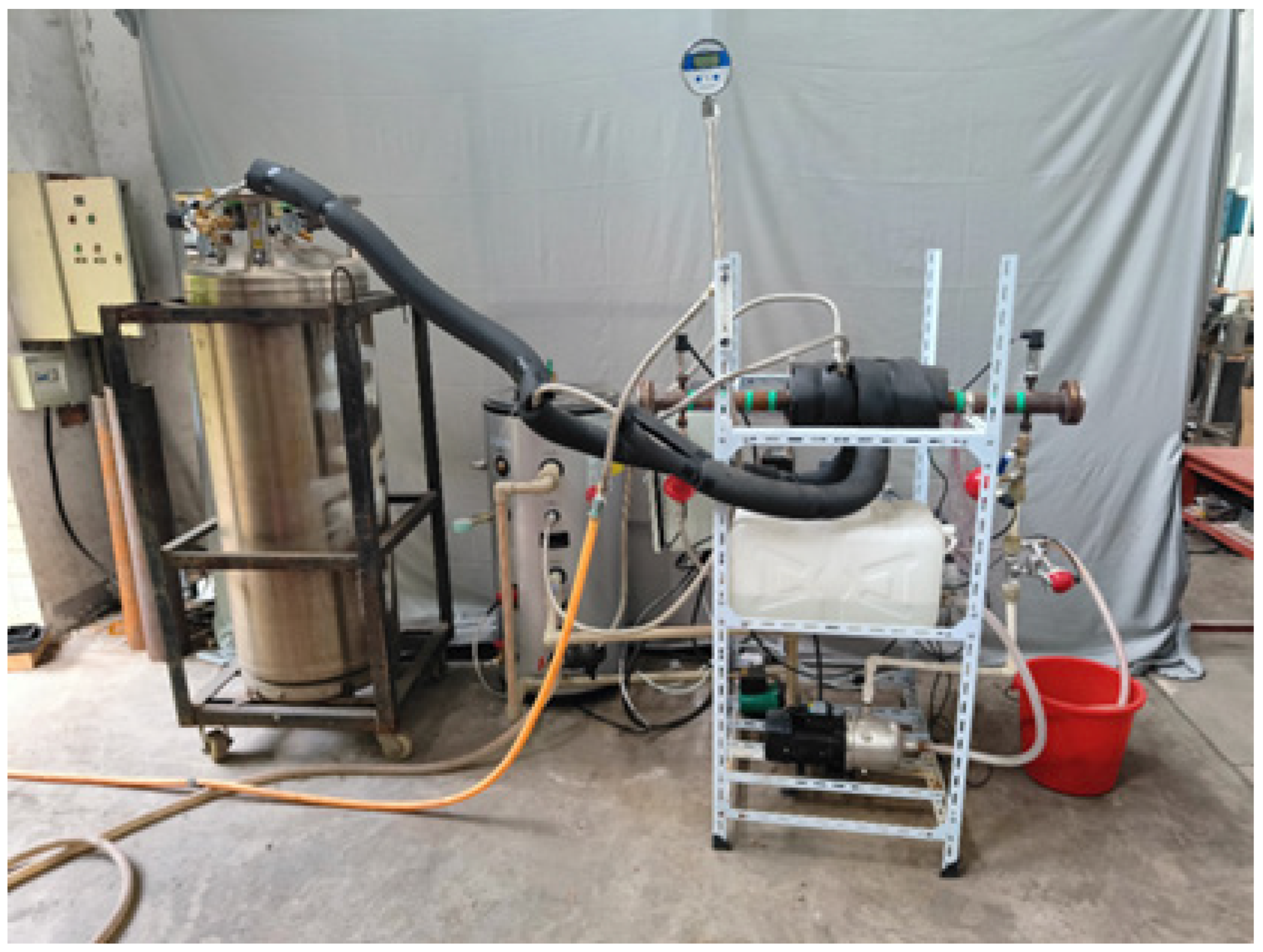
| Physical Parameters | Values |
|---|---|
| internal diameter of the pipeline | 50 mm |
| external diameter of the pipeline | 54 mm |
| pipeline wall thickness | 2 mm |
| external diameter of the jacket | 118 mm |
| internal diameter of the jacket | 114 mm |
| jacket thickness | 2 mm |
| jacket inlet diameter | 10 mm |
| jacket outlet diameter | 10 mm |
| pipeline length | 450 mm |
| distance between jacket ends and pipeline ends | 150 mm |
| helical pipeline diameter | 20 mm |
| pitch of helical fins | 23 mm |
| spacing between labyrinth baffles | 23 mm |
| Type | Method |
|---|---|
| Wall function | Standard wall function |
| Inlet type | Velocity inlet |
| Outlet type | Pressure outlet |
| Pressure type | Standard pressure type |
| Solution method | SIMPLEC |
| T (K) | λ (W/(m⋅K)) | ρ (kg/m3) | Cp (KJ/(kg⋅K)) | |
|---|---|---|---|---|
| Water | 313.15 | 0.631 | 990.58 | 4.18 |
| 293.15 | 0.598 | 997.98 | 4.184 | |
| 273.15 | 0.552 | 999.84 | 4.22 | |
| 263.15 | 2.3 | 916.79 | 2.1 | |
| 213.15 | 2.94 | 924 | 1.658 | |
| 173.15 | 3.49 | 928 | 1.389 | |
| Liquid nitrogen | 77 | 0.14581 | 806.08 | 2.0415 |
| Helical Jacket | Helical Fin Jacket | Labyrinth Jacket | Standard Jacket | |
|---|---|---|---|---|
| Nu number | 197.7229 | 225.9943 | 239.7979 | 183.2073 |
| 1021.35 | 835.69 | 975.43 | 712.23 | |
| 0.957038 | 1.169534 | 1.178629 | 1 |
| Type | Test Number | Freezing Time |
|---|---|---|
| experimental results | 1 | 584 s |
| experimental results | 2 | 670 s |
| simulation results | 1 | 559 s |
| simulation results | 2 | 559 s |
Disclaimer/Publisher’s Note: The statements, opinions and data contained in all publications are solely those of the individual author(s) and contributor(s) and not of MDPI and/or the editor(s). MDPI and/or the editor(s) disclaim responsibility for any injury to people or property resulting from any ideas, methods, instructions or products referred to in the content. |
© 2024 by the authors. Licensee MDPI, Basel, Switzerland. This article is an open access article distributed under the terms and conditions of the Creative Commons Attribution (CC BY) license (https://creativecommons.org/licenses/by/4.0/).
Share and Cite
Zhang, W.; Xu, K.; Hu, M.; Liang, H.; Chen, H.; Wang, L.; Feng, Y. Research on the Structural Performance of Liquid Nitrogen Ice Plugs on Nuclear Power Pipes. Energies 2024, 17, 4211. https://doi.org/10.3390/en17174211
Zhang W, Xu K, Hu M, Liang H, Chen H, Wang L, Feng Y. Research on the Structural Performance of Liquid Nitrogen Ice Plugs on Nuclear Power Pipes. Energies. 2024; 17(17):4211. https://doi.org/10.3390/en17174211
Chicago/Turabian StyleZhang, Wei, Ke Xu, Minglei Hu, Huijie Liang, Hao Chen, Liqun Wang, and Yongqiang Feng. 2024. "Research on the Structural Performance of Liquid Nitrogen Ice Plugs on Nuclear Power Pipes" Energies 17, no. 17: 4211. https://doi.org/10.3390/en17174211
APA StyleZhang, W., Xu, K., Hu, M., Liang, H., Chen, H., Wang, L., & Feng, Y. (2024). Research on the Structural Performance of Liquid Nitrogen Ice Plugs on Nuclear Power Pipes. Energies, 17(17), 4211. https://doi.org/10.3390/en17174211






